Biomedical NiTi and β-Ti Alloys: From Composition, Microstructure and Thermo-Mechanics to Application
Abstract
:1. Introduction
2. Materials and Methods
2.1. Materials
2.2. Physical Property Determination
2.2.1. Size Conformability
2.2.2. Surface Morphology Determination with Scanning Electron Microscopy (SEM)
2.2.3. Surface Characteristics and Roughness Determination with Atomic Force Microscope
2.2.4. Microstructure Examination with Light Microscope
2.2.5. Crystal Structure and Phase Composition Determination with Neutron Diffraction
2.2.6. NiTi Phase Transition Temperature Determination
2.3. Chemical Composition Determination
2.4. Mechanical Property Determination
2.4.1. Hardness Determination with Vickers Test
2.4.2. Three-Point Bending Test
2.5. Statistical Analyses
3. Results
3.1. Physical Properties
3.1.1. Size Conformability
3.1.2. Surface Morphology Determined with SEM
3.1.3. Surface Characteristics and Roughness Determined with AFM
3.1.4. Light Microscopy Observations
3.1.5. Crystal Structure and Phase Composition Determined with Neutron Diffraction
3.1.6. NiTi Phase Transition Temperatures
3.2. Chemical Composition
3.3. Mechanical Properties
3.3.1. Vickers Hardness
3.3.2. Three-Point Bending Test Result
3.4. Pearson Correlation
4. Discussion
5. Conclusions
Supplementary Materials
Author Contributions
Funding
Institutional Review Board Statement
Informed Consent Statement
Data Availability Statement
Acknowledgments
Conflicts of Interest
References
- Meyers, M.A.; Chen, P.-Y.; Lopez, M.I.; Seki, Y.; Lin, A.Y. Biological materials: A materials science approach. J. Mech. Behav. Biomed. Mater. 2011, 4, 626–657. [Google Scholar] [CrossRef] [PubMed]
- Wever, D.; Veldhuizen, A.; De Vries, J.; Busscher, H.; Uges, D.; Van Horn, J. Electrochemical and surface characterization of a nickel–titanium alloy. Biomaterials 1998, 19, 761–769. [Google Scholar] [CrossRef]
- Trépanier, C.; Tabrizian, M.; Yahia, L.; Bilodeau, L.; Piron, D.L. Effect of modification of oxide layer on NiTi stent corrosion resistance. J. Biomed. Mater. Res. 1998, 43, 433–440. [Google Scholar] [CrossRef]
- Sevcikova, J.; Goldbergova, M.P. Biocompatibility of NiTi alloys in the cell behavior. Biometals 2017, 30, 163–169. [Google Scholar] [CrossRef] [PubMed]
- Nespoli, A.; Dallolio, V.; Stortiero, F.; Besseghini, S.; Passaretti, F.; Villa, E. Design and thermo-mechanical analysis of a new NiTi shape memory alloy fixing clip. Mater. Sci. Eng. C 2014, 37, 171–176. [Google Scholar] [CrossRef]
- Ryhänen, J.; Kallioinen, M.; Tuukkanen, J.; Junila, J.; Niemelä, E.; Sandvik, P.; Serlo, W. In vivo biocompatibility evaluation of nickel-titanium shape memory metal alloy: Muscle and perineural tissue responses and encapsule membrane thickness. J. Biomed. Mater. Res. 1998, 41, 481–488. [Google Scholar] [CrossRef]
- Otsuka, K.; Wayman, C.M. Shape Memory Materials; Cambridge University Press: Cambridge, MA, USA, 1998. [Google Scholar]
- Sherif, M.M.; Ozbulut, O.E. Tensile and superelastic fatigue characterization of NiTi shape memory cables. Smart Mater. Struct. 2018, 27, 015007. [Google Scholar] [CrossRef]
- Nespoli, A.; Villa, E.; Bergo, L.; Rizzacasa, A.; Passaretti, F. DSC and three-point bending test for the study of the thermo-mechanical history of NiTi and NiTi-based orthodontic archwires. J. Therm. Anal. 2015, 120, 1129–1138. [Google Scholar] [CrossRef]
- Frenzel, J.; George, E.; Dlouhy, A.; Somsen, C.; Wagner, M.; Eggeler, G. Influence of Ni on martensitic phas’e transformations in NiTi shape memory alloys. Acta Mater. 2010, 58, 3444–3458. [Google Scholar] [CrossRef]
- Melton, K.N. Ni-Ti Based Shape Memory Alloys. In Engineering Aspects of Shape Memory Alloys; Duerig, T.W., Melton, K.N., Stöckel, D., Wayman, C.W., Eds.; Butterworth-Heinemann Ltd.: Oxford, UK, 1990; pp. 21–35. [Google Scholar]
- Nishida, M.; Wayman, C.M.; Honma, T. Precipitation processes in near-equiatomic TiNi shape memory alloys. Met. Mater. Trans. A 1986, 17, 1505–1515. [Google Scholar] [CrossRef]
- Nespoli, A. ICMATE. unpublished study.
- Goldberg, A.J.; Burstone, C.J. An evaluation of beta titanium alloys for use in orthodontic appliances. J. Dent. Res. 1979, 58, 593–600. [Google Scholar] [CrossRef]
- Burstone, C.J.; Goldberg, A. Beta titanium: A new orthodontic alloy. Am. J. Orthod. 1980, 77, 121–132. [Google Scholar] [CrossRef]
- Chen, L.-Y.; Cui, Y.-W.; Zhang, L.-C. Recent Development in Beta Titanium Alloys for Biomedical Applications. Metals 2020, 10, 1139. [Google Scholar] [CrossRef]
- Tian, K.V.; Festa, G.; Basoli, F.; Laganà, G.; Scherillo, A.; Andreani, C.; Bollero, P.; Licoccia, S.; Senesi, R.; Cozza, P. Orthodontic archwire composition and phase analyses by neutron spectroscopy. Dent. Mater. J. 2017, 36, 282–288. [Google Scholar] [CrossRef] [Green Version]
- Tian, K.V.; Passaretti, F.; Nespoli, A.; Placidi, E.; Condò, R.; Andreani, C.; Licoccia, S.; Chass, G.A.; Senesi, R.; Cozza, P. Composition―Nanostructure Steered Performance Predictions in Steel Wires. Nanomaterials 2019, 9, 1119. [Google Scholar] [CrossRef] [Green Version]
- Khier, S.E.; Brantley, W.A.; Fournelle, R.A. Structure and mechanical properties of as-received and heat-treated stainless steel orthodontic wires. Am. J. Orthod. Dentofac. Orthop. 1988, 93, 206–212. [Google Scholar] [CrossRef]
- World Health Organization (WHO). Medical Device Regulations, Global Overview and Guiding Principles; WHO: Geneva, Switzerland, 2003. [Google Scholar]
- ISO 13485:2016; Quality Systems-Quality Management Systems-Requirements for Regulatory Purposes. International Organization for Standardization: London, UK, 2016.
- Tian, K.; Darvell, B.W. Determination of the flexural modulus of elasticity of orthodontic archwires. Dent. Mater. 2010, 26, 821–829. [Google Scholar] [CrossRef]
- Pynn, R. Neutron Scattering—A Non-destructive Microscope for Seeing Inside Matter. In Neutron Scattering Applications and Techniques; Anderson, I.S., Hurd, A.J., McGreevy, R.L., Eds.; Springer: Berlin/Heidelberg, Germany, 2004; ISSN 1868-0372. [Google Scholar]
- Brantley, W.A.; Eliades, T. Orthodontic Materials: Scientific and Clinical Aspects. Thieme Medical Publishers: New York, NY, USA, 2004; pp. 78–100. [Google Scholar]
- Nečas, D.; Klapetek, P. Gwyddion: An open-source software for SPM data analysis. Open Phys. 2012, 10, 181–188. [Google Scholar] [CrossRef]
- Pietropaolo, A.; Festa, G.; Grazzi, F.; Barzagli, E.; Scherillo, A.; Schooneveld, E.M.; Civita, F. A multitask neutron beam line for spallation neutron sources. Eur. Lett. 2011, 95, 48007. [Google Scholar] [CrossRef] [Green Version]
- Szentmiklósi, L.; Kis, Z.; Belgya, T.; Berlizov, A.N. On the Design and Installation of a Compton-Suppressed HPGe Spectrometer at the Budapest Neutron-Induced Prompt Gamma Spectroscopy (NIPS) Facility. J. Radioanal. Nucl. Chem. 2013, 298, 1605–1611. [Google Scholar] [CrossRef]
- Kis, Z.; Szentmiklósi, L.; Belgya, T. NIPS–NORMA Station—A Combined Facility for Neutron-Based Nondestructive Element Analysis and Imaging at the Budapest Neutron Centre. Nucl. Instrum. Methods Phys. Res. Sect. A 2015, 779, 116–123. [Google Scholar] [CrossRef]
- Fazekas, B.; Belgya, T.; Dabolczi, L.; Molnár, G.; Simonits, A. Hypermet-PC: Program for automatic analysis of complex gamma- ray spectra. J. Trace Microprobe Tech. 1996, 14, 167–172. [Google Scholar]
- Reévay, Z. Determining Elemental Composition Using Prompt γ Activation Analysis. Anal. Chem. 2009, 81, 6851–6859. [Google Scholar] [CrossRef] [PubMed]
- ISO 15841:2014; Dentistry—Wires for Use in Orthodontics. International Organization for Standardization: London, UK, 2014.
- Timoshenko, S. Strength of Materials, 3rd ed.; Krieger: New York, NY, USA, 1976. [Google Scholar]
- Student. The Probable Error of a Mean. Biometrika 1908, 6, 1–25. [Google Scholar] [CrossRef]
- Council on Dental Materials and Devices. New American Dental Association Specification No. 32 for Orthodontic Wires Not Containing Precious Metals. Council on Dental Materials and Devices. J. Am. Dent. Assoc. 1977, 95, 1169–1171. [Google Scholar] [CrossRef]
- Larson, A.C.; von Dreele, R.B. General Structure Analysis System (GSAS). In Los Alamos National Laboratory Report; Regents of the University of California: Los Alamos, NM, USA, 1994; pp. 86–748. [Google Scholar]
- Toby, B.H. EXPGUI, a graphical user interface for GSAS. J. Appl. Crystallogr. 2001, 34, 210–213. [Google Scholar] [CrossRef] [Green Version]
- McNaney, J.M.; Imbeni, V.; Jung, Y.; Papadopoulos, P.; Ritchie, R. An experimental study of the superelastic effect in a shape-memory Nitinol alloy underbiaxial loading. Mech. Mater. 2003, 35, 969–986. [Google Scholar] [CrossRef]
- Fu, C.H.; Sealy, M.P.; Guo, Y.B.; Wei, X.T. Austenite-martensite phase transformation of biomedical Nitinol by ball bur-nishing. J. Mater. Processing Technol. 2014, 214, 3122–3130. [Google Scholar] [CrossRef]
- Kusy, R.P.; Tobin, E.J.; Whitley, J.Q.; Sioshansi, P. Frictional coefficients of ion-implanted alumina against ion-implanted beta titanium in the low load, low velocity, single pass regime. Dent. Mater. 1992, 8, 167–172. [Google Scholar] [CrossRef]
- Tian, K.V.; Mahmoud, M.Z.; Cozza, P.; Licoccia, S.; Fang, D.-C.; Di Tommaso, D.; Chass, G.A.; Greaves, G.N. Periodic vs. molecular cluster approaches to resolving glass structure and properties: Anorthite a case study. J. Non-Cryst. Solids 2016, 451, 138–145. [Google Scholar] [CrossRef]
- Tian, K.V.; Chass, G.A.; Tommaso, D.D. Simulations reveal the role of composition into the atomic-level flexibility of bioac-tive glass cements. Phys. Chem. Chem. Phys. 2016, 18, 837–845. [Google Scholar] [CrossRef]
- Tian, K.V.; Festa, G.; Szentmiklósi, L.; Maróti, B.; Arcidiacono, L.; Laganà, G.; Andreani, C.; Licoccia, S.; Senesi, R.; Cozza, P. Compositional studies of functional orthodontic archwires using prompt-gamma activation analysis at a pulsed neutron source. J. Anal. At. Spectrom. 2017, 32, 1420–1427. [Google Scholar] [CrossRef]
- Johnson, E. Relative stiffness of beta titanium archwires. Angle Orthod. 2003, 73, 259–269. [Google Scholar]
- Niinomi, M.; Nakai, M. Titanium-Based Biomaterials for Preventing Stress Shielding between Implant Devices and Bone. Int. J. Biomater. 2011, 2011, 836587. [Google Scholar] [CrossRef] [Green Version]
- Révay, Z.; Belgya, T. Principles of PGAA Method. In Handbook of Prompt Gamma Activation Analysis with Neutron Beams; Molnár, G.L., Ed.; Kluwer Academic Publishers: Dordrecht, The Netherlands; Boston, MA, USA; New York, NY, USA, 2004; pp. 1–30. [Google Scholar]

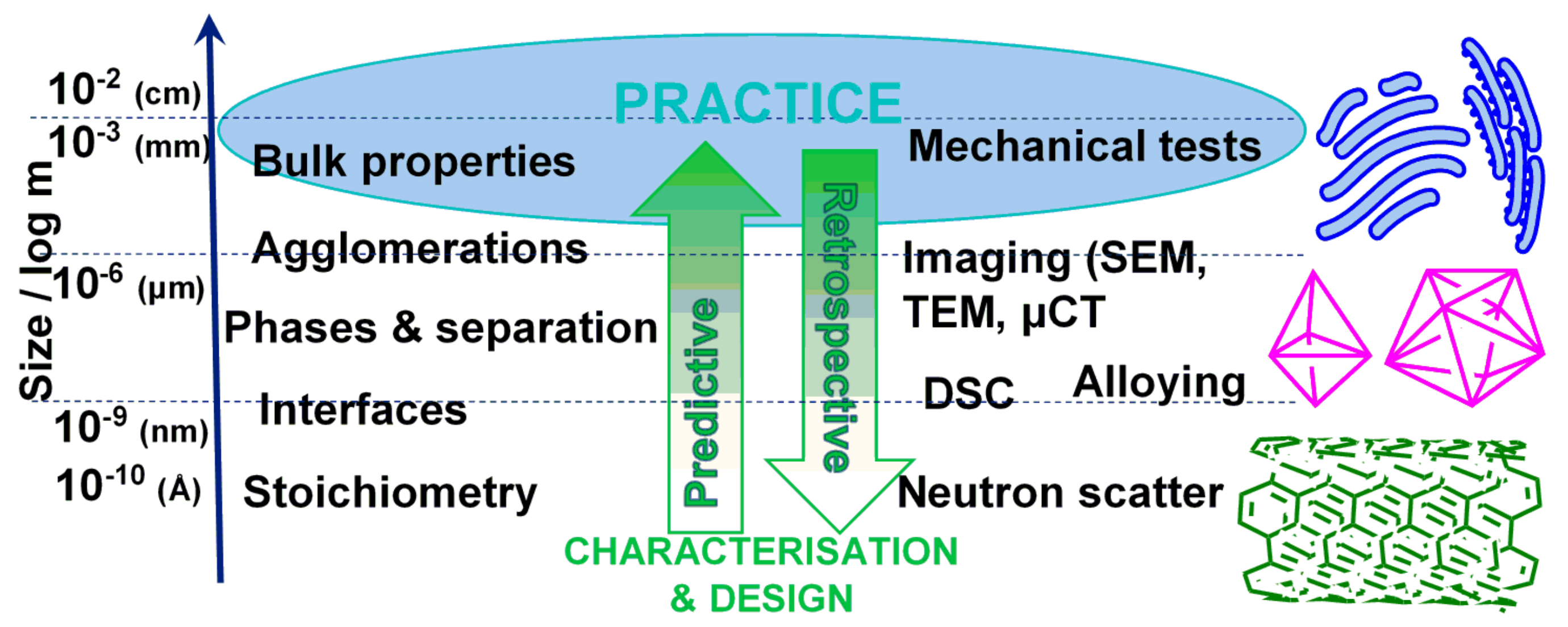
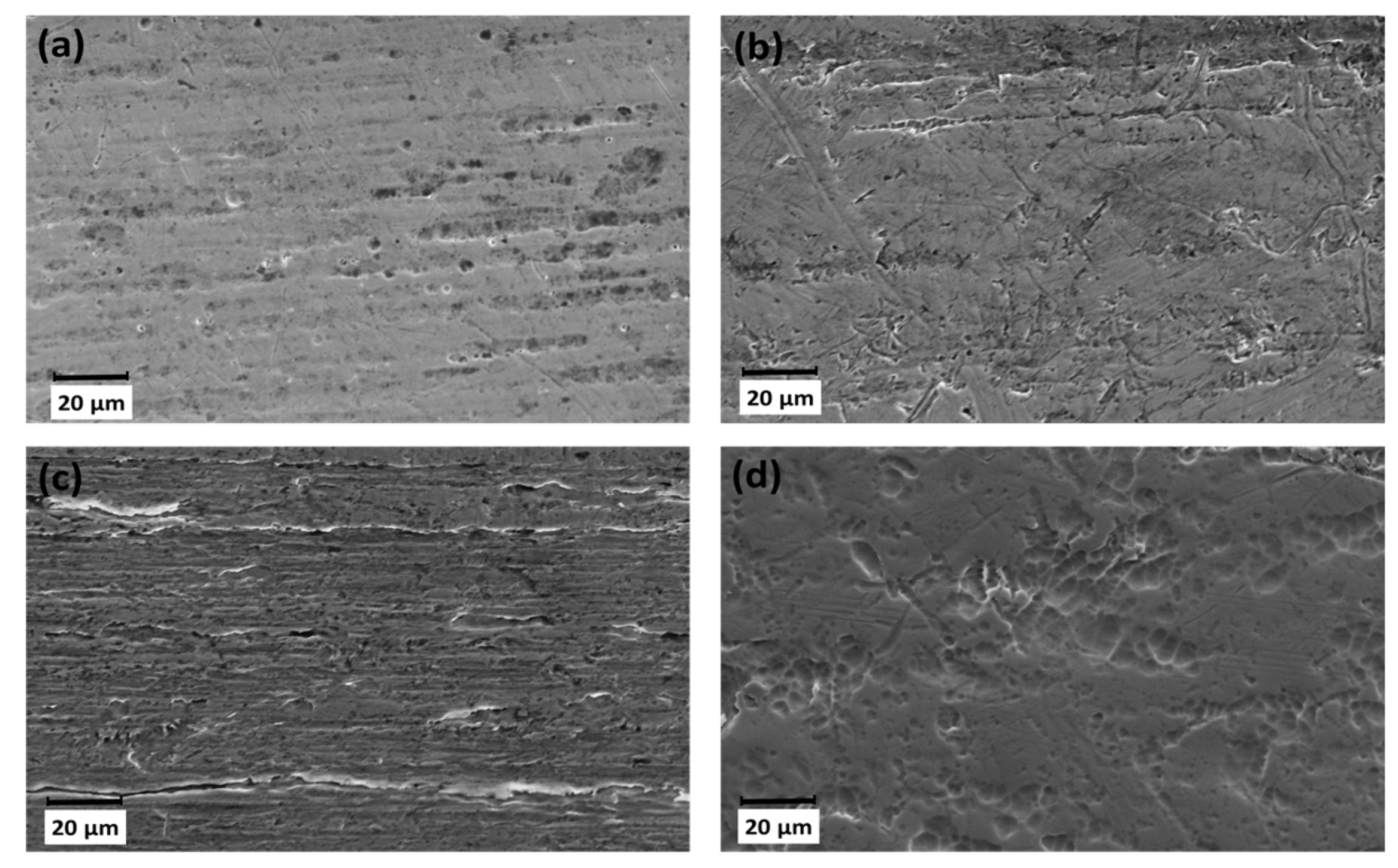
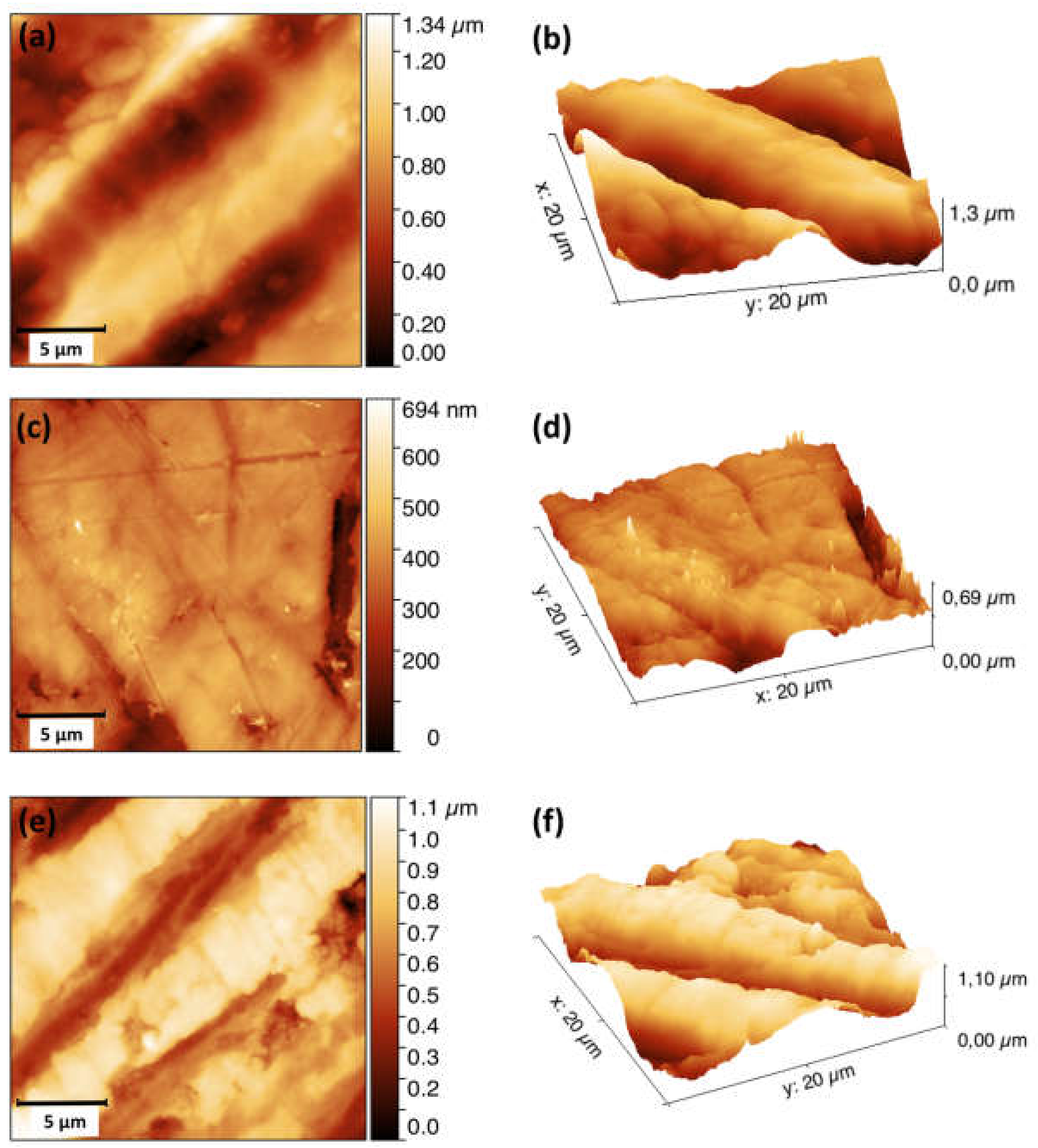

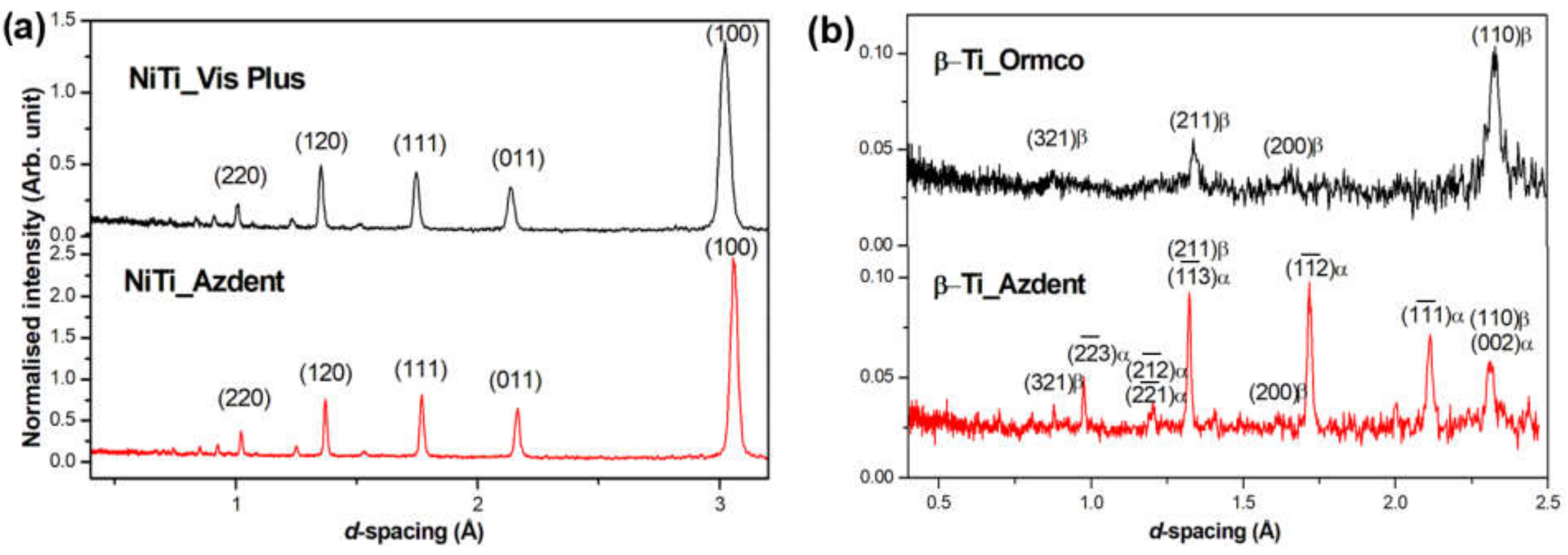
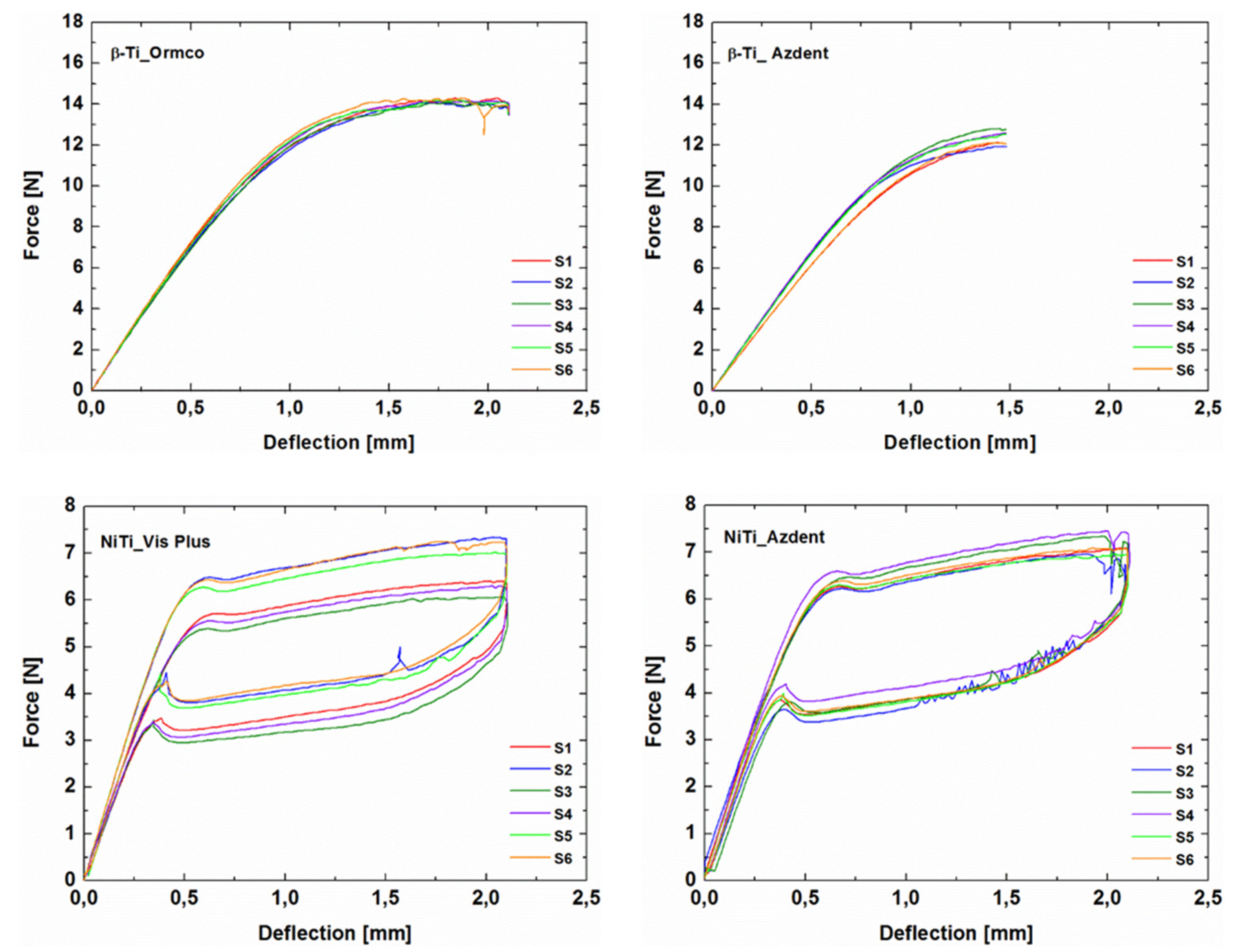
| Alloy | Brand | Height (mm) | p | Dev043 (%) | Width (mm) | p | Dev064 (%) | Deq (mm) | D* (mm) |
|---|---|---|---|---|---|---|---|---|---|
| NiTi | Vis Plus | 0.440 (0.005) | 0.271 | 2.3 | 0.640 (0.015) | 0.938 | 0 | 0.5996 | 0.0069 |
| Azdent | 0.437 (0.003) | 1.6 | 0.640 (0.003) | 0 | 0.5976 | 0.0048 | |||
| β-Ti | Ormco | 0.441 (0.003) | 0.000 | 2.6 | 0.628 (0.002) | 0.786 | −2.8 | 0.5957 | 0.0019 |
| Azdent | 0.423 (0.008) | −1.6 | 0.627 (0.007) | −3.0 | 0.5819 | −0.0109 |
| Alloy | Brands | RMS (nm) | p | Ra (nm) | p | HV0.2 | HV (GPa) | p |
|---|---|---|---|---|---|---|---|---|
| Vis Plus | 350 (25) | 0.12 | 290 (20) | 0.11 | 371.31 (12.98) | 3.64 (0.13) | <0.001 | |
| NiTi | Azdent | 270 (40) | 225 (30) | 397.62 (11.85) | 3.90 (0.12) | |||
| Ormco | 320 (10) | ― | 270 (10) | ― | 353.91 (8.89) | 3.47 (0.09) | 0.905 | |
| β-Ti | Azdent | ― | 354.52 (14.47) | 3.48 (0.14) |
| Alloy | Structure | Brand | |
|---|---|---|---|
| Vis Plus | Azdent | ||
| NiTi | B2 austenite | 100% | 100% |
| a = b = c | 3.019887 Å | 3.019887 Å | |
| α = β = γ | 90° | 90° | |
| β-Ti | Ormco | Azdent | |
| β phase | 100% | 58.8% | |
| a = b = c | 3.282744 Å | 3.282927 Å | |
| α = β = γ | 90° | 90° | |
| α phase | 0% | 41.2% | |
| a = b ≠ c | ― | 2.97000 Å | |
| c | ― | 4.72000 Å | |
| α = β | ― | 90° | |
| γ | ― | 120° | |
| Brand | Specimen | As-received | Solubilized | ||||||||||
|---|---|---|---|---|---|---|---|---|---|---|---|---|---|
| Heating | Cooling | Heating | Cooling | ||||||||||
| Rs (°C) | Rp (°C) | Ap (°C) | Af (°C) | ΔHM-A (J/g) | Rs (°C) | Rp (°C) | Rf (°C) | Ms (°C) | ΔHA-R (J/g) | Af (°C) | Ms (°C) | ||
| Vis Plus | S1 | −1.7 | 11.5 | 21.3 | 26.5 | 9.14 | 25.5 | 18.7 | 10 | −45.6 | 7.16 | 4 | −17.7 |
| S2 | −8.4 | 3.6 | 13.4 | 17.7 | 10.33 | 17.3 | 11 | 3.1 | −52.4 | 5.77 | 1.3 | −20.5 | |
| S3 | −5.6 | 9.2 | 16.7 | 21.2 | 14.41 | 21.2 | 14.5 | 7.1 | −43.8 | 6.39 | ― | ― | |
| S4 | −4.8 | 7.8 | 16.8 | 22.6 | 12.06 | 23.1 | 13.7 | 6.5 | −47.9 | 6.61 | ― | ― | |
| S5 | −9.9 | 1.6 | 10.8 | 15 | 12.20 | 14.2 | 8.5 | 2.1 | −52.1 | 6.20 | ― | ― | |
| S6 | −8.6 | 2.7 | 12.5 | 16.9 | 10.43 | 16 | 9.8 | 2.5 | −53 | 6.47 | ― | ― | |
| Azdent | S1 | −11 | 4.9 | 16.9 | 24.1 | 9.29 | 20.5 | 12.6 | 3.6 | −63.3 | −5.24 | ― | ― |
| S2 | −7.1 | 7 | 19.7 | 27.2 | 9.19 | 24.7 | 15.1 | 5.1 | −49.3 | −3.46 | ― | ― | |
| S3 | −3.3 | 7.7 | 21.4 | 29 | ― | 25.6 | 17.8 | 8.3 | −54.3 | ― | ― | ― | |
| S4 | −4.5 | 6.3 | 19.1 | 26.5 | 8.89 | 23 | 13.6 | 5.1 | −55 | −3.46 | ― | ― | |
| S5 | −5.1 | 6.6 | 18.4 | 26.2 | 10.05 | 22.5 | 14 | 5.3 | −41 | −2.72 | 5.1 | −17.1 | |
| S6 | −4.9 | 5.4 | 18 | 25.5 | 8.62 | 22 | 13.4 | 4.5 | −50.1 | −3.33 | 3.7 | −17.6 | |
| Alloy | Brand | Ni | Ti | Mo | Zr | Sn |
|---|---|---|---|---|---|---|
| NiTi | Vis Plus | 56.0 (1.0) | 44.0 (0.6) | ― | ― | ― |
| Azdent | 56.0 (0.7) | 44.0 (0.7) | ― | ― | ― | |
| β-Ti | Ormco | ― | 77.0 (0.9) | 11.6 (0.6) | 6.0 (0.5) | 5.0 (0.8) |
| Azdent | ― | 81.0 *(0.7) | 10.2 *(0.4) | 5.0 *(0.5) | 3.4 *(0.5) |
| FS(0,1) (N) | p | FΔ (N/mm) | p | E (GPa) | p | |
|---|---|---|---|---|---|---|
| Ormco | 10.22 (0.35) | 0.170 | 15.12 (0.29) | 0.0007 | 70.54 (2.35) | 0.613 |
| Azdent | 9.94 (0.32) | 13.64 (0.69) | 72.35 (8.20) |
| Bending Forces during Unloading (N) | E (GPa) | p | ||||||||
|---|---|---|---|---|---|---|---|---|---|---|
| F1 | p | F2 | p | F3 | p | F4 | p | |||
| Vis Plus | 5.17 (0.43) | 0.075 | 4.04 (0.42) | 0.208 | 3.45 (0.40) | 0.418 | 3.46 (0.30) | 0.861 | 62.23 (4.66) | 0.99 |
| Azdent | 5.52 (0.08) | 4.28 (0.13) | 3.60 (0.14) | 3.43 (0.21) | 62.25 (2.73) | |||||
Publisher’s Note: MDPI stays neutral with regard to jurisdictional claims in published maps and institutional affiliations. |
© 2022 by the authors. Licensee MDPI, Basel, Switzerland. This article is an open access article distributed under the terms and conditions of the Creative Commons Attribution (CC BY) license (https://creativecommons.org/licenses/by/4.0/).
Share and Cite
Nespoli, A.; Passaretti, F.; Szentmiklósi, L.; Maróti, B.; Placidi, E.; Cassetta, M.; Yada, R.Y.; Farrar, D.H.; Tian, K.V. Biomedical NiTi and β-Ti Alloys: From Composition, Microstructure and Thermo-Mechanics to Application. Metals 2022, 12, 406. https://doi.org/10.3390/met12030406
Nespoli A, Passaretti F, Szentmiklósi L, Maróti B, Placidi E, Cassetta M, Yada RY, Farrar DH, Tian KV. Biomedical NiTi and β-Ti Alloys: From Composition, Microstructure and Thermo-Mechanics to Application. Metals. 2022; 12(3):406. https://doi.org/10.3390/met12030406
Chicago/Turabian StyleNespoli, Adelaide, Francesca Passaretti, László Szentmiklósi, Boglárka Maróti, Ernesto Placidi, Michele Cassetta, Rickey Y. Yada, David H. Farrar, and Kun V. Tian. 2022. "Biomedical NiTi and β-Ti Alloys: From Composition, Microstructure and Thermo-Mechanics to Application" Metals 12, no. 3: 406. https://doi.org/10.3390/met12030406







